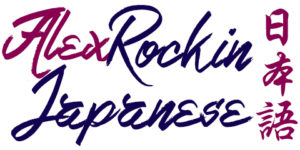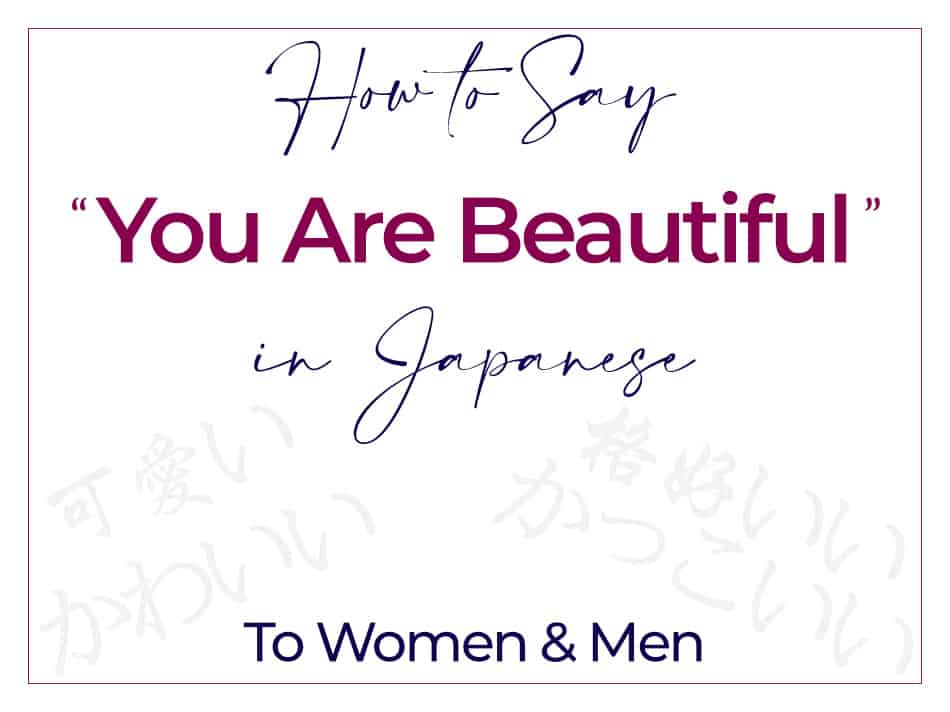Telling someone “You are beautiful” in Japanese is a bit more tricky than in English because there are a lot of different words that mean “beautiful” or “pretty“. Not only the words but also the phrases you should use are different for women and men. So in this blog post, I explain to you exactly how to say that someone looks pretty in Japanese.
To say “You are beautiful” in Japanese you can use either of the phrases below:
- Simply say: “Kawaii!”, “Kirei!”, or “Kakko ii!”
- To a woman: “Kimi wa kawaii” or “(Name)-chan wa kawaii”
- To a man: “(Name)-kun wa kakko ii”
- “(Name)-san wa kirei” can be used for both
- “Anata wa kirei” to your partner
Below I will give you a detailed explanation of why you should use “kawaii” for girls and women, but “kakko ii” for boys and men. You will also find a lot of example sentences and you are going to learn how to spice up your phrases by saying “You are so beautiful“.
How to Say “You Are Beautiful” to Women and Men in Japanese
Before we are going to take a detailed look at the best phrases to say “You are beautiful” to each gender, let’s take a brief look at the most commonly used Japanese words for “beautiful” and “pretty”.
How to Say “Beautiful” and “Pretty” in Japanese?
Kawaii (可愛い), kirei (綺麗), kakko ii (カッコいい, 格好いい), and hansamu (ハンサム) are the most frequently used words to say someone is “beautiful” or “pretty” in Japanese. Utsukushii (美しい) is another word that means “beautiful” but it is only used for extremely beautiful or gorgeous people, nature, and things.
| Kawaii cute, pretty, lovely, charming | 可愛い かわいい |
| Kirei beautiful, pretty | 綺麗 きれい |
| Kakko ii cool, handsome, attractive | カッコいい 格好いい |
| Hansamu handsome | ハンサム |
| Utsukushii extremely beautiful, gorgeous | 美しい |
| Suteki lovely, beautiful (character) | 素敵 |
| Bijin beautiful woman | 美人 |
| Ikemen beautiful man | イケメン |
| Bishoujo beautiful girl | 美少女 |
| Bishounen beautiful boy | 美少年 |
1. Kawaii – For Cute and Pretty Girls & Women
Kawaii (可愛い) means “cute“, “adorable“, “charming“, “lovely“, or “pretty“. Foreign women usually don’t like to be called “cute”, but most Japanese women like to be called “kawaii“. So while the word translates as “cute” in English its meaning is closer to “pretty” or “beautiful” and extremely positive.
To tell a girl or woman that they look pretty or cute, just saying “kawaii” is more than enough. However, the full sentences “Kimi wa kawaii” (君は可愛い) or “(Name) wa kawaii” (〇〇は可愛い) are also commonly used. After the person’s name, you can add the cute-sounding honorific chan (ちゃん) or for someone you have just met the polite suffix san (さん).
For boys and men, I personally prefer using other words and phrases. However, generally, it is possible to say something like “Me ga kawaii” (目が可愛い) which means “Your eyes are cute/pretty” or “(Name)-kun wa kawaii” (〇〇くんは可愛い) to a male. Kun (くん) is another Japanese honorific mostly used for boys.
It is also common to add emphasis and say “so pretty” or “Pretty!” by adding one or more sentence ending particles such as na (な), yo (よ), or ne (ね).
| Kawaii You’re cute/pretty. | 可愛い かわいい カワイイ |
| (Name + chan/san) wa kawaii. You’re cute/pretty. | 〇〇は可愛い。 〇〇はかわいい。 |
| Kimi wa kawaii ne. You’re cute/pretty. | 君は可愛いね。 君はかわいいね。 |
2. Kirei – For Beautiful Women and Sometimes Men
The next word on our list is kirei (綺麗, きれい, キレイ) which means “pretty” or “beautiful” but sometimes it is also translated as “clean” or “tidy”. In my opinion, it is the second most frequently used word to describe someone or something as beautiful or pretty. However, it is more commonly used for beautiful women than for beautiful men.
In my opinion, the word “kirei” feels more genuine and meaningful than “kawaii”, but that’s probably just the case because “kawaii” is used for everything and anything. You can hear it all the time in Japan since everything looks “kawaii” and especially women tend to describe everything they see as “kawaii”.
So whenever a Japanese guy says to you “Kirei” or tells you “Kimi wa kirei” (君は綺麗) you should be extremely happy. If you want to say it to a Japanese man I would rather use the next phrase or say something like “(Name + kun or san) no kao ga kirei” (〇〇の顔が綺麗) which means “You have a beautiful face” or “Your face is beautiful“.
“Da yo” (だよ) can also be used to add emphasis to what you are saying. It is often used in combination with “kirei (da yo)” but also other words such as “kawaii (da yo)“. Instead of “da yo” you can also say “da ne” and “da na“.
| Kirei You’re beautiful. | 綺麗 きれい キレイ |
| Kimi wa kirei. You’re beautiful. | 君は綺麗。 君はきれい。 |
| (Name + chan/kun/san) wa kirei da yo. You’re beautiful! | 〇〇は綺麗だよ。 〇〇はきれいだよ。 |
| (Name + chan/kun/san) no kao ga kirei. You have a beautiful face. Your face is beautiful. | 〇〇の顔が綺麗。 〇〇の顔がきれい。 |
3. Kakko ii – For Beautiful and Cool Boys & Men
Kakko ii (カッコいい, 格好いい, カッコイイ) means “attractive“, “good-looking“, “cool“, or “stylish” in English and is the most common Japanese word to tell a boy or man “You’re beautiful” or “You look beautiful“. In my opinion, it is the best choice to compliment a good-looking boy or an attractive man.
In contrast to “kirei” and especially “kawaii”, “kakko ii” sounds more masculine. So instead of “beautiful” or “pretty”, I tend to translate “Kakko ii!” or “(Name + kun or san) wa kakko ii” (〇〇はカッコいい) as “You look cool” or “You’re cool“.
I have also added the example “Anata wa kakko ii” (あなたはカッコいい), but honestly, I do not recommend using this phrase unless you are in a relationship with someone. Anata (貴方, あなた) means “you” just like kimi (君), but while “kimi” is usually only used when talking to a girl or woman, “anata” is gender-neutral and can be used for both genders.
Please note that “anata” is more commonly used by women, though, and usually only to address their husband or boyfriend.
| Kakko ii You’re cool/beautiful. | カッコいい 格好いい カッコイイ |
| (Name + kun/san) wa kakko ii. You’re cool/beautiful. | 〇〇はカッコいい。 〇〇は格好いい。 |
| Anata wa kakko ii. You’re cool/beautiful. | あなたはカッコいい。 あなたは格好いい。 |
4. Hansamu – For Handsome Boys & Men
If you are a bit familiar with Japanese you may have immediately recognized that hansamu (ハンサム) is an English loan word that means “handsome“. Judging from my own experience here in Japan, it is among the most often used words to describe a man or boy as beautiful together with “kakko ii” and “ikemen”.
Since “hansamu” is a loan word, it doesn’t sound as convincing and meaningful as “kakko ii”. That is actually quite often the case with borrowed words in Japanese. Renai (恋愛), for example, is one of the 11 words for “love” in Japanese but it sounds less romantic than the other words due to its Chinese origin.
That is why I personally prefer to use “kakko ii”. However, I think “hansamu” is a good word if you are a bit shy or if you want to tone it down so that you don’t reveal your secret crush.
| Hansamu You’re handsome/beautiful. | ハンサム |
| (Name + kun/san) wa hansamu. You’re handsome/beautiful. | 〇〇はハンサム。 |
5. Utsukushii – Extremely Beautiful or Gorgeous
When I checked other forums, I saw that a lot of people suggested using utsukushii (美しい) to tell someone that they look pretty. While it is true that the word translates as “beautiful” in English, it is only used for extremely beautiful or gorgeous-looking people. Its meaning is closer to “gorgeous“.
On the day of your wedding ceremony, for example, if you tell your bride that she looks “utsukushii“, I think she will accept the compliment and feel very happy. However, in normal everyday situations, the word is a little too much.
“Utsukushii” is actually more frequently used when talking about nature, beautiful landscapes, extremely scenic places, and other exceptionally beautiful objects. So my recommendation is to stick with “kawaii” and “kirei“.
However, if you are dying to use this word I suggest talking about something more specific such as her (or his) beautiful face (kao, 顔), beautiful smile (egao, 笑顔), beautiful lips (kuchibiru, 唇), etc.
| Utsukushii You look gorgeous. | 美しい |
| Utsukushii kao She/He has a gorgeous/extremely beautiful face. | 美しい顔 |
| Utsukushii egao You have a gorgeous smile. Your smile is extremely beautiful. | 美しい笑顔 |
| Utsukushii kuchibiru Your lips are gorgeous. Your lips are extremely beautiful. | 美しい唇 |
6. Bijin, Bishojo, Ikemen, and Bishonen
These four words are so similar that we are going to discuss them together. Bijin (美人) means “beautiful woman” or “pretty woman” and ikemen (イケメン) means “beautiful man” or “pretty man“. The other two words bishoujo (美少女) and bishounen (美少年) mean “beautiful girl” and “beautiful boy” respectively.
“Bijin” and “ikemen” are frequently used in daily life and TV shows to talk about attractive-looking women or as a compliment for handsome-looking men. “Bishoujo” and “bishonen“, on the other hand, I have only encountered in regards to anime, manga, and game genres. But maybe just because I’m not a high-school kid anymore and I don’t hang out with other high-school kids…
I can’t really explain why but I don’t recommend using these words once you are dating someone seriously. Before or on the first date they might still be appropriate, but after that, I would switch to one of the words or phrases above, because they sound more authentic and less flirty, I guess.
| Bijin You’re a beautiful woman | 美人 |
| Ikemen You’re a beautiful man | イケメン |
| Bishoujo You’re a beautiful girl | 美少女 |
| Bishounen You’re a beautiful boy | 美少年 |
How to Say “You Are So Beautiful” in Japanese
“Mecha kawaii” (めちゃ可愛い) and “Sugoku kirei” (すごくきれい, 凄くきれい) are more casual phrases that mean “You are so beautiful” in Japanese. “Hontou ni kirei” (本当にきれい) and “Totemo kirei/kakko ii” (とてもきれい/カッコいい) are more formal phrases that translate as “You are really beautiful” or “You are very beautiful“.
You can also combine mecha (めちゃ) with “kirei” and “kakko ii“, of course, and the same is true for the other words. So “hontou ni kawaii” (本当に可愛い) and “totemo kawaii” (とても可愛い) as well as “sugoku kakko ii” and “hontou ni kakko ii“, etc. are also possible.
The following list contains just a few examples to give you an idea of how you can use mecha (めちゃ), sugoku (凄く, すごく), hontou ni (本当に), and totemo (とても). I have also sneaked in two additional phrases “kawaisugi” and “kakko yosugi” which translate as “too cute” and “too cool” – just because I can.
| Mecha kawaii You’re so cute/pretty. | めちゃ可愛い めちゃかわいい |
| Sugoku kirei You are so beautiful. | 凄く綺麗 すごく綺麗 |
| Hontou ni kirei da You are really beautiful | 本当に綺麗だ 本当にきれいだ |
| (Name) wa totemo kirei desu You look very beautiful. | 〇〇はとても綺麗です 〇〇はとてもきれいです |
| Kawaisugi You are too cute. | 可愛すぎ |
| Kakko yosugi You look too cool. | カッコよすぎ 格好よすぎ |



Thank you, I appreciate it!
Hey Camiseta,
thanks a lot for saying thank you and leaving a comment.
Please let me know if you need any other phrases or resources!
Kind regards,
Alex